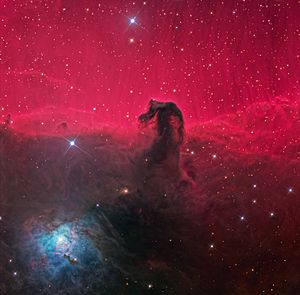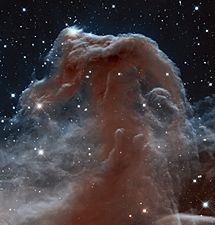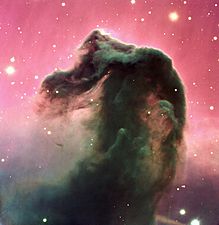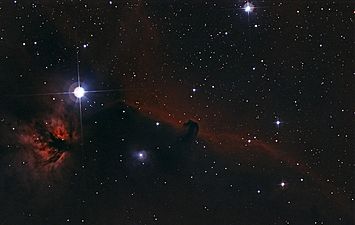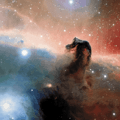Horsehead nebula facts for kids
The Horsehead Nebula is a famous cloud of dust and gas in space. It is also known as Barnard 33. This amazing nebula is found in the constellation Orion, which is easy to spot in the night sky.
The Horsehead Nebula is a type of space cloud called a dark nebula. This means it looks dark because its thick dust blocks the light from stars behind it. It is part of a much bigger area called the Orion Molecular Cloud Complex. This huge complex is where new stars are being born.
You can find the Horsehead Nebula just south of the bright star Alnitak. Alnitak is one of the stars that makes up Orion's Belt.
Contents
Discovering the Horsehead Nebula
The Horsehead Nebula was first seen and recorded in 1888. A Scottish astronomer named Williamina Fleming discovered it. She found it on a special photographic plate, which is like an old-fashioned photo. This plate was taken at the Harvard College Observatory.
The Horsehead Nebula is about 1,500 light years away from Earth. A light-year is how far light travels in one year. That's a very long distance! It is one of the most well-known nebulae because of its unique shape. From Earth, it really looks like the head of a horse.
What the Horsehead Nebula is Made Of
The Horsehead Nebula is a big cloud of dust and gas. This cloud is a special place in the Orion Nebula where new stars are forming. It contains many different kinds of gases. Scientists have found over 100 known organic and inorganic gases there. It also has large and complex organic molecules.
The beautiful red or pink glow you see around the Horsehead comes from hydrogen gas. This hydrogen gas is located behind the dark nebula. Magnetic fields in space help to shape the gases leaving the nebula. This creates streaks that you can see against the glowing background.
A bright strip of hydrogen gas marks the edge of this massive cloud. The number of stars is different on either side of this glowing edge. The dark shape of the Horsehead is caused by thick dust. This dust blocks the light from the stars that are behind it.
If you look closely, you might see bright spots at the base of the Horsehead's "neck." These bright spots are actually very young stars. They are just beginning to form inside the nebula.
-
Hubble Space Telescope infrared image.
-
From the European Southern Observatory, 2002
Images for kids
-
Orion's Belt with Alnitak on the left-hand side and the Horsehead Nebula directly below it
-
Interstellar dust of the Horsehead Nebula as revealed by the Hubble Space Telescope
See also
 In Spanish: Nebulosa Cabeza de Caballo para niños
In Spanish: Nebulosa Cabeza de Caballo para niños


